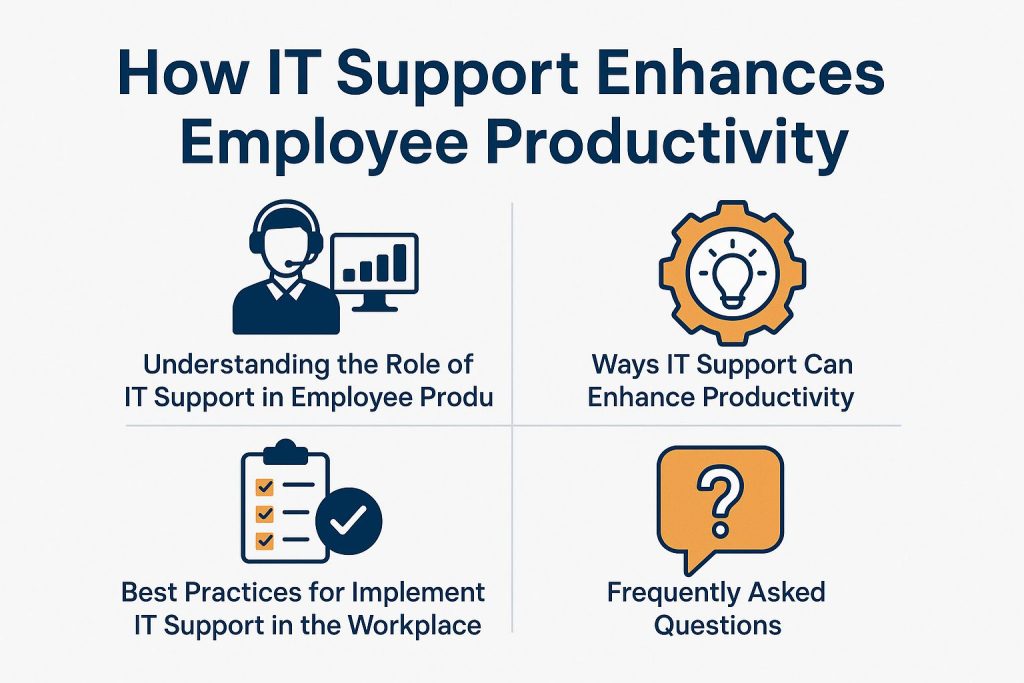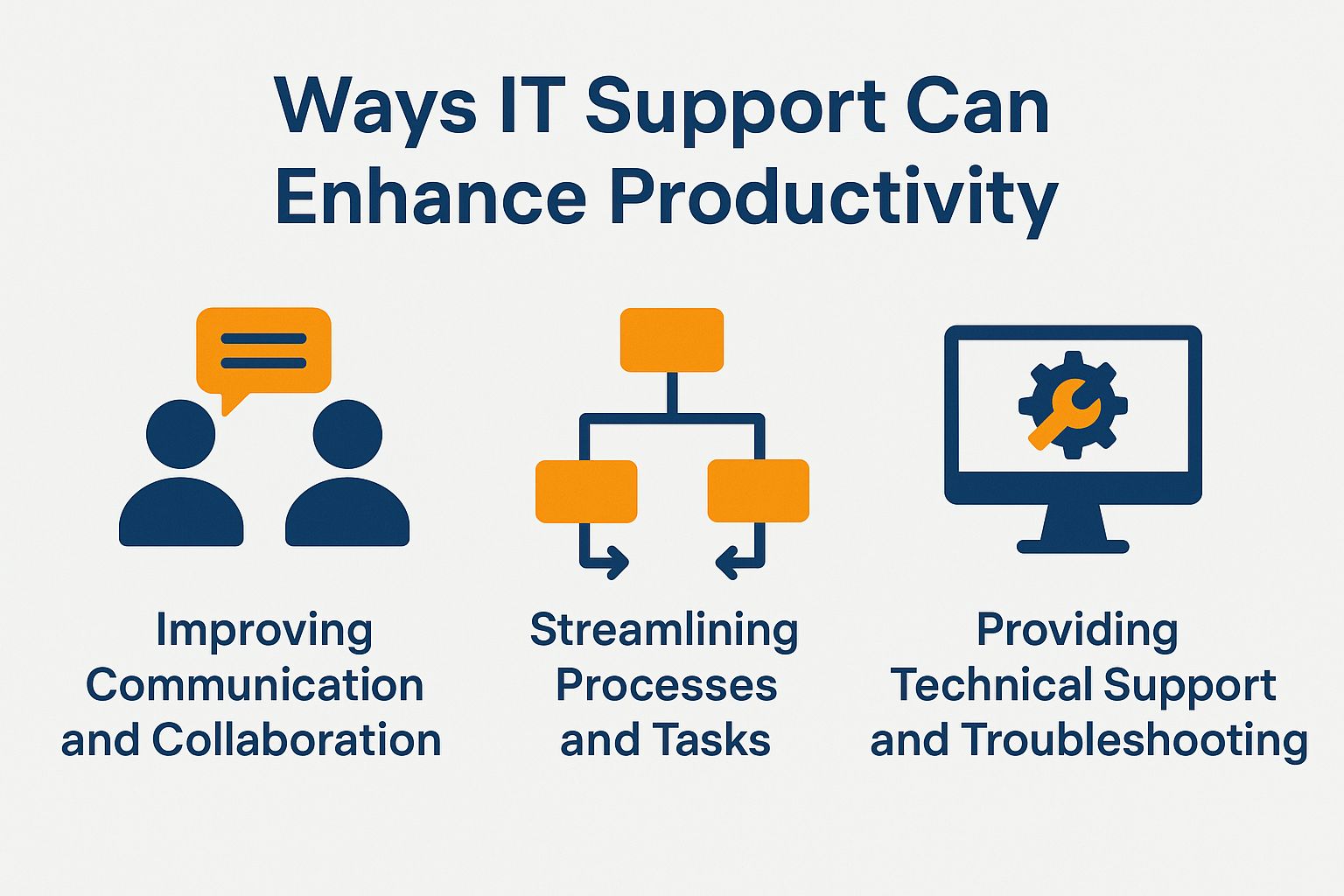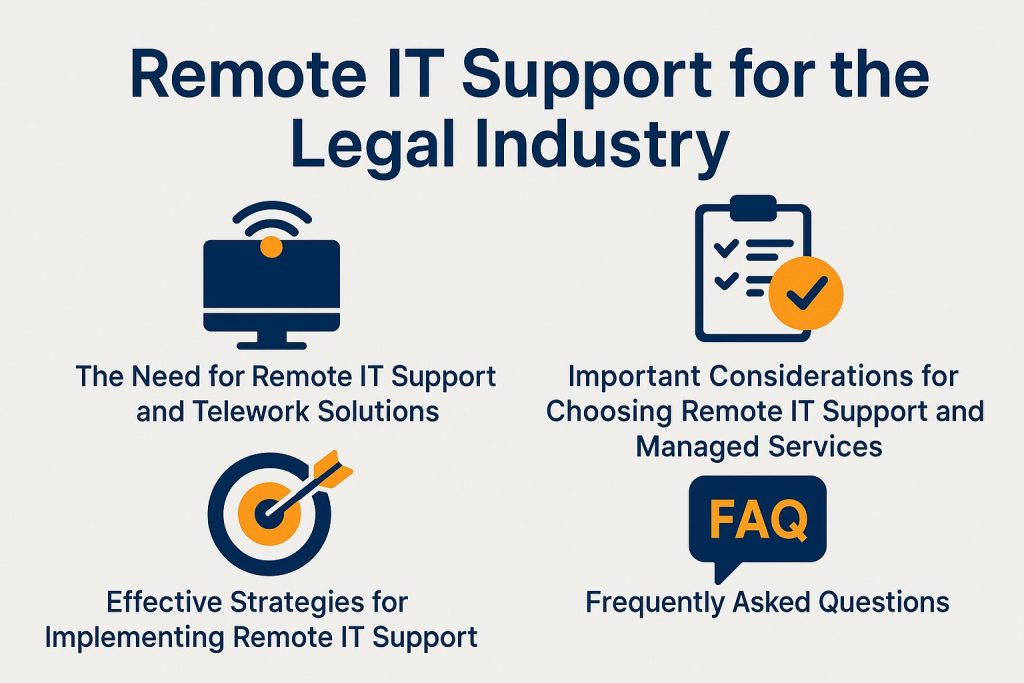How IT Support Enhances Employee Productivity

Today, IT support is essential for enhancing employee productivity. IT support improves communication and resolves technical issues. This increases workplace efficiency. We will explore how IT support impacts workplace efficiency. This article examines how a robust IT support system can improve productivity by streamlining processes, boosting cooperative efforts, and providing critical troubleshooting assistance. Additionally, it will discuss best practices for implementing IT support, ensuring that employees are equipped with the tools and knowledge they need to succeed. The significant impact of IT support on workplace efficiency will be further explored throughout the discussion.
Understanding the Role of IT Support in Employee Productivity
IT Support serves a vital role in enhancing employee productivity by offering technical assistance, problem-solving, and issue resolution, enabling employees to effectively navigate their technological environment.
This function resolves issues. It also improves user experience and service quality, affecting how efficient IT services are. Understanding common pitfalls in IT management can further refine these services, as elaborated in IT Mistakes in a Growing Business: How to Avoid Them.
By implementing an IT strategy that aligns with business objectives, IT Support teams can proactively tackle challenges that affect employee satisfaction, employee engagement, and productivity levels throughout the organization.
Importance of IT Support in the Workplace
The importance of IT support in the workplace is paramount, serving as the backbone for seamless operations and influencing various aspects from user experience to service quality, response time, and customer satisfaction.
An effective help desk quickly resolves support queries. This prevents long downtimes that can lower employee engagement and productivity. Adequate IT support fosters a culture in which employees feel enableed to leverage technology without fear of failure.
When tech issues are fixed quickly, employees stay productive. This boosts morale and fosters a positive workplace. Beyond mere problem-solving, proactive IT support anticipates potential challenges by providing training and resources that enhance overall service quality.
Consequently, staff members become more adept at utilizing various tools, which translates into better collaboration and innovation.
This focused approach not only builds trust in the IT department but also ensures that the entire organization operates at peak efficiency, reinforcing the significance of IT support as a critical component of a successful workplace.
Ways IT Support Can Enhance Productivity
IT support plays a crucial role in enhancing employee productivity through various initiatives designed to optimize workflows, process automation, and minimize technical barriers. For businesses looking to improve these areas, exploring IT Solutions in Charleston SC can build a smarter, stronger foundation.
Using good collaboration tools and timely support improves communication among teams. This helps complete tasks efficiently.
Additionally, remote support capabilities enable IT personnel to quickly address issues, thereby minimizing disruptions and maximizing productivity throughout the organization.

Improving Communication and Collaboration
Good communication and collaboration are key for a productive workplace. IT support improves collaboration through various tools. These tools facilitate seamless communication among employees and enhance employee engagement by enableing users to work together efficiently. Consequently, effective IT solutions that focus on collaboration can lead to improved project outcomes and heightened employee satisfaction.
By streamlining the way teams interact, these collaborative technologies encourage open dialogue, reduce misunderstandings, and nurture a culture of transparency. When employees feel connected and involved, they are more likely to contribute their ideas and insights, which can spur innovation and creativity.
IT support provides training and ongoing help with these tools. This ensures employees are comfortable using features that enhance connectivity. In turn, a well-integrated set of collaboration tools not only boosts morale but also strengthens team dynamics, ultimately driving organizations toward their collective goals.
Streamlining Processes and Tasks
Streamlining processes and tasks is essential for efficiency. IT support helps through workflow optimization, performance improvement, and task automation. By continuously assessing IT operations and implementing process improvement strategies, teams can eliminate redundancies and enhance overall productivity. Efficient processes lead to quicker problem resolution and a more focused workforce.
In this context, automated tools handle repetitive tasks with little human input. This allows employees to focus on more strategic initiatives. The integration of robust IT support systems enables employees by providing them with readily available resources and information necessary for effective performance in their roles.
By focusing on continuous improvement, organizations streamline operations and build a foundation for innovation. A proactive IT support strategy cultivates a culture of productivity and collaboration, ultimately driving organizational success.
Providing Technical Support and Troubleshooting
Providing effective technical support and remote troubleshooting are fundamental functions of IT support. They ensure employees have the resources to resolve issues quickly. A reliable help desk is critical for efficient incident management, enabling timely user support that minimizes downtime and maintains high productivity levels.
This proactive approach is essential for ensuring smooth operational flow within the organization.
In today’s fast-paced work environment, where technology plays a crucial role in daily operations, the importance of such support systems is paramount. Employees frequently encounter unforeseen technical challenges that, if not addressed swiftly, can disrupt workflows and lead to operational delays.
Help desk services are the first line of defense. They provide immediate solutions and help users learn how to prevent future issues.
Effective incident management ensures that recurring problems are identified and resolved, contributing to long-term reliability. By investing in these resources, companies can protect productivity and foster a more efficient workplace.
Best Practices for Implementing IT Support in the Workplace
Implementing strong IT support requires following best practices and IT governance that align with the organization’s IT strategy and goals.
Establishing clear Service Level Agreements (SLAs) is crucial to ensure that IT teams meet the support expectations of employees and enhance employee empowerment. Furthermore, investing in employee training on IT tools and resources enhances user proficiency and promotes a more effective IT infrastructure. Avoiding common IT mistakes in a growing business is essential to maintain system efficiency and support overall business growth.

Creating a Comprehensive IT Support System
Creating a comprehensive IT support system involves integrating various components such as a responsive Help Desk, cloud services, a well-developed Knowledge Base, and strict adherence to IT governance principles. A well-structured system provides effective user support. It ensures employees can access information to resolve common issues on their own.
This self-service approach significantly enhances overall efficiency and productivity.
By fostering an environment where users can easily find solutions, the organization enables its workforce while simultaneously reducing the strain on IT resources. In this context, Help Desk services play a pivotal role in addressing complex issues that require human intervention, acting as the frontline for technical support.
Meanwhile, an organized Knowledge Base serves as a repository for insightful articles, troubleshooting guides, and best practices.
Together, these elements promote continuous learning and improvement. They align with strong IT governance strategies to meet operational and compliance standards.
Training and Educating Employees on IT Tools and Resources
Training employees on IT tools is crucial. It ensures the workforce can use technology effectively.
Targeted learning helps employees navigate complex systems. Employees adapt to new technologies with confidence. This improves individual skills. It also creates a collaborative environment for knowledge sharing.
Proficient employees improve IT compliance. They follow company protocols and regulations.
Well-trained employees boost productivity. They streamline processes, reduce errors, and innovate solutions that align with the organization’s goals. Comprehensive training helps companies thrive in a digital landscape.
Regular Maintenance and Upgrades for IT Infrastructure
Regular maintenance and upgrades for IT infrastructure are essential. They ensure network reliability and business continuity. By prioritizing system maintenance practices and timely system upgrades, IT support and technology adoption can minimize the risk of downtime and performance issues, thereby fostering an environment that supports productivity tools and user satisfaction.
A proactive approach to infrastructure and IT service management is vital today.
Investing in regular reviews helps organizations address vulnerabilities. They can also adapt quickly to new technologies and threats, ensuring process optimization and system reliability.
This strategy protects vital data and enhances system robustness. It allows teams to work efficiently without interruptions, promoting task management and workflow improvement.
Consistent upgrades ensure compatibility with the latest software. This is critical for maintaining a competitive edge and operational effectiveness, ensuring IT solutions and technology integration.
For an extensive analysis of this trend, our comprehensive guide on avoiding IT mistakes in a growing business examines key strategies.
These practices create a framework for business success. They ensure resources are used well and minimize operational risks, backed by IT governance and user feedback systems.
Frequently Asked Questions
What is IT support and how does it enhance employee productivity and resource allocation?
IT support enhances productivity by ensuring technology works properly. This allows employees to work efficiently without interruptions.
What are the main benefits of having IT support and virtual support in the workplace?
IT support increases productivity, improves efficiency, and reduces downtime. It lets employees focus on work without worrying about technical issues or troubleshooting devices, fostering workplace technology and collaboration software.
How does IT support help in minimizing downtime and disruptions for employees through proactive support?
IT support minimizes downtime by monitoring and maintaining systems. They prevent issues before they occur, engaging in issue tracking and user training. They provide quick solutions when problems arise, minimizing interruptions to employees’ work.
Can IT support enhance employee productivity in remote work settings and ensure access to resources?
Yes, IT support enhances productivity in remote work by providing assistance and troubleshooting for technical issues that employees may face while working from home. This allows employees to stay connected and productive even when they are not physically in the office.
What type of IT support services are typically offered to enhance employee productivity and skill development?
Common IT support services include help desk support, hardware maintenance, network security, and data backup. These services ensure employees have reliable technology to support their work, thanks to responsive IT support and support tickets.
How IT Support Enhances Work Environment and Employee Satisfaction
IT support creates a positive work environment. It helps employees feel secure and improves their well-being. When IT support is available, employees can focus on their tasks. They don’t have to worry about technical issues. This leads to greater productivity. IT training programs also help improve efficiency.




